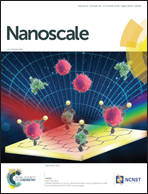Electrically pumped Fabry–Perot microlasers from single Ga-doped ZnO microbelt based heterostructure diodes†
Abstract
Semiconducting micro/nanostructures possessing naturally optical waveguiding behaviors and Fabry–Perot (F–P) like resonances are emerging as versatile building blocks for the assembly of photonic and optoelectronic devices, such as photodetectors, light-emitting diodes, lasers and so on. Individual ZnO micro/nanowires with a rectangular cross-section, such as microwires and microbelts possessing naturally smooth facets along both sides for good optical feedback, can be employed as an underlying F–P mode microcavity whilst as the gain medium for light amplification. In this context, electrically pumped F–P mode microlasers comprising a single ZnO:Ga microbelt and p-GaN substrate have been realized. By treating as the precondition, electrically driven exciton–polariton light-emitting behavior was achieved from the heterojunction diodes, which could be ascribed to strong exciton–photon coupling and waveguided nature of the synthesized microbelts. Once the applied bias exceeded the threshold value, an electrically pumped F–P mode lasing behavior could be observed, the lasing peaks centered at 410.5 nm and 450.5 nm respectively, accompanied with a dramatic narrowing of the spectral line-width to be around 1.0 nm emerging on the waveguided emission spectrum. Therefore, the realization of electrically pumped F–P mode lasing using single microbelt based heterojunction diodes opens the door not only to the fabrication of coherent light sources and model systems for waveguided resonators, but also affords a competitive candidate to develop electrically pumped and ultralow threshold polariton lasers.



 Please wait while we load your content...
Please wait while we load your content...